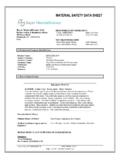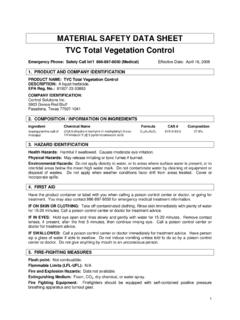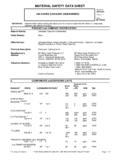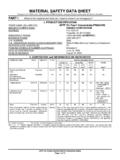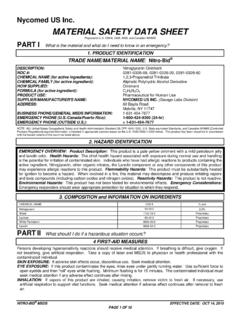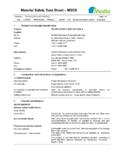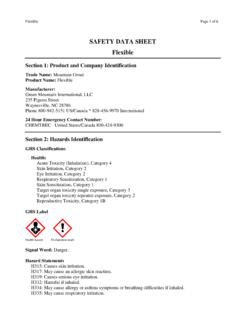Transcription of MATERIAL SAFETY DATA SHEET - RHH Foam …
1 RHH FOAM SYSTEMS INC. FOR EMERGENCY, CALL CHEMTREC: 1-800-424-9300 17100 WEST VICTOR ROAD OUTSIDE , CALL COLLECT: 001-(703) 527-3887 NEW BERLIN WI 53151-4139 USA 1-800-657-0702 DATE OF PREPARATION: March 1, 2010 (262) 754-8088 PREPARED BY: Debra M. Buss MATERIAL SAFETY data SHEET SECTION 1 - PRODUCT IDENTIFICATION Name of product: VERSI-FOAM Systems I, 15, 50 and pcf Refillable - Standard Component A SECTION 2 - CHEMICAL COMPOSITION CHEMICAL CAS # CONCENTRATION Polymethylene polyphenyl isocyanate 9016-87-9 80% to 100% Containing 4,4 Methylene bisphenylisocyanate (MDI) 101-68-8 (Approximately 40% - 50% MDI) Tetrafluoroethane (134a) 811-97-2 <15% SECTION 3 - HAZARDS IDENTIFICATION EMERGENCY OVERVIEW Brown liquid. Slightly Musty. Sprayed or heated MATERIAL harmful if inhaled. May cause allergic skin reaction.
2 May cause allergic respiratory reaction and lung injury. Avoid temperatures above 105 F (41 C). Toxic flammable gases and heat are released under decomposition conditions. Toxic fumes may be released in fire situations. Reacts slowly with water, releasing carbon dioxide, which can cause pressure buildup and rupture of closed containers. Elevated temperatures accelerate this process. POTENTIAL HEALTH EFFECTS (See section 11 for toxicological data ) Eyes: May cause moderate eye irritation. May cause very slight transient (temporary) corneal injury. Skin: Prolonged or repeated exposure may cause slight irritation. May cause allergic skin reaction in susceptible individuals. Animal studies have shown that skin contact with isocyanates may play a role in respiratory sensitization. May stain skin. A single prolonged exposure is not likely to result in the MATERIAL being absorbed in harmful amounts. Ingestion: Single dose oral toxicity is considered to be low.
3 No hazards anticipated from swallowing small amounts incidental to normal handling operations. Inhalation: At room temperature, vapors are minimal due to low vapor pressure. Excessive exposure may cause irritation of the eyes, upper respiratory tract, and pulmonary edema (fluid in lungs). May cause respiratory sensitization to susceptible individuals. MDI concentrations below the exposure guidelines may cause allergic respiratory reactions in individuals already sensitized. Symptoms may include coughing, difficult breathing and a feeling of tightness in the chest. Effects may be delayed. Decreased lung function has been associated with overexposure to isocyanates. Systemic (other target organ) Effects: Tissue injury in the upper respiratory tract and lung has been observed in laboratory animals after repeated excessive exposures to MDI/polymeric MDI aerosols. Cancer Information: Lung tumors have been observed in laboratory animals exposed to aerosol droplets of MDI/Polymeric MDI (6 mg/m3) for their lifetime.
4 Tumors occurred concurrently with respiratory irritation and lung injury. Current exposure guidelines are expected to protect against these effects reported by MDI. Teratology (Birth Defects): In laboratory animals, MDI/polymeric MDI did not cause birth defects; other fetal effects occurred only at high doses which were toxic to the mother. SECTION 4 - FIRST AID PROCEDURES Eye Contact: Irrigate with flowing water immediately and continuously for 15 minutes. Consult medical personnel. Skin Contact: Remove MATERIAL from skin immediately by washing with soap and plenty of water (warm water is preferable if readily available). Remove contaminated clothing and shoes while washing. Seek medical attention if irritation persists. An MDI skin decontamination study demonstrated that cleaning very soon after exposure is important, and that a polyglycol-based skin cleanser or corn oil may be more effective than soap and water. MSDS - VERSI-FOAM SYSTEMS I, 15, 50 and REFILLABLE STANDARD COMPONENT A PAGE TWO Ingestion: If swallowed, seek medical attention.
5 Do not induce vomiting unless directed to do so by medical personnel. Inhalation: Remove to fresh air. If not breathing, give artificial respiration. If breathing is difficult, oxygen should be administered by qualified personnel. Call a physician or transport to a medical facility. NOTE TO PHYSICIAN: No specific antidote. Supportive care. Treatment based on judgment of the physician in response to reactions of the patient. May cause respiratory sensitization or asthma-like symptoms. Bronchodilators, expectorants, and antitussives may be of help. Respiratory symptoms, including pulmonary edema, may be delayed. Persons receiving significant exposure should be observed for 24-48 hours for signs of respiratory distress. SECTION 5 - FIRE FIGHTING MEASURES Flash Point >400 F (204 C)(estimated) via PMCC, ASTM D93 Autoignition Temperature >1100 F (600 C) Flammability Limits LFL: Not Applicable; UFL: Not Applicable Hazardous Combustion Products During a fire, smoke may contain the original MATERIAL in addition to unidentified toxic and/or irritating toxic and/or irritating compounds.
6 Hazardous combustion products may include but are not limited to: nitrogen oxides, isocyanates, hydrogen cyanide, carbon monoxide and carbon dioxide. Other Flammability Information: Product reacts with water. Reaction may produce heat and/or gases. Reaction may be violent. Container may rupture from gas generation in a fire situation. Violent steam generation or eruption may occur upon application of direct water stream to hot liquids. Dense smoke is produced when product burns. Spills of these organic liquids on hot fibrous insulations may lead to lowering of the autoignition temperatures possibly resulting in spontaneous combustion. Extinguishing Media: Carbon Dioxide, Dry Chemical, Foam, Water Fog or Fine Spray. Alcohol resistant foams (ATC type) are preferred if available. General purpose synthetic foams (including AFFF) or protein foams may function, but less effectively.
7 Do not use direct water stream. May spread fire. Fire Fighting Instructions: Keep people away. Isolate fire area and deny unnecessary entry. Stay upwind. Keep out of low areas where gases (fumes) can accumulate. Water is not recommended but may be applied in very large quantities as a fine spray when other extinguishing agents are not available. Contain fire water run-off if possible. Do not use direct water stream. May spread fire. Fight fire from protected location or safe distance. Consider use of unmanned hose holder or monitor nozzles. Use water spray to cool fire exposed containers and fire affected zone until fire is out. Immediately withdraw all personnel from area in case of rising sound from venting SAFETY device or discoloration of the container. Move container from fire area if this is possible without hazard. Protective Equipment for Firefighters: Wear positive-pressure self-contained breathing apparatus (SCBA) and protective fire fighting clothing (includes fire fighting helmet, coat, pants, boots and gloves).
8 Avoid contact with this MATERIAL during fire fighting operations. If contact is likely, change to full chemical resistant clothing with SCBA. This will not provide sufficient fire protection, consider fighting fire from a remote location. For protective equipment in post-fire or non-fire cleanup situations, refer to relevant sections. SECTION 6 ACCIDENTAL RELEASE MEASURES (See Section 15 for Regulatory Information) Protect People: Avoid any contact. Barricade area. Clear non-emergency personnel from area. Keep upwind of spill. Ventilate area of leak or spill. The area must be evacuated and reentered by persons equipped for decontamination. Use appropriate SAFETY equipment. If available, use foam to suppress vapors. For additional information, refer to Exposure Controls/Personal Protection , MSDS Section 8. See Stability and Reactivity MSDS Section 10. Protect the Environment: Contain liquid to prevent contamination of soil, surface water or ground water.
9 Keep out of ditches, sewers and water supplies. Should the product enter sewers or drains, it should be pumped into an open vessel. Emergency services may need to be called to assist in the cleanup operation. Clean Up: Supplies of suitable decontaminant should always be kept available. Absorb with MATERIAL such as: sawdust, vermiculite, dirt, sand, clay, cob grit, Milsorb. Avoid materials such as cement powder. Collect MATERIAL in suitable and properly labeled open containers. Do not place in sealed container. Prolonged contact with water results in a chemical reaction which may result in rupture of the container. Place in: polylined fiber pacs, plastic drums or properly labeled metal containers. Remove to a well ventilated area. Clean up floor areas. Attempt to neutralize by decontaminant solution: Formulation No. 1: Sodium Carbonate (5%-10%), Liquid Detergent ( ) and water to make up 100%. Or, Formulation No.
10 2: Concentrated Ammonia Solution (3% -8%), Liquid Detergent ( ) and water to make up 100%. If ammonia is used, use good ventilation to prevent vapor exposure. If you have any questions on how to neutralize, call RHH Foam Systems Inc. Refer to Disposal Information MSDS Section 13. See Sections 7 and 15 for more specific information. SECTION 7 HANDLING AND STORAGE Handling: Avoid contact of this product with water at all times during handling and storage. Use only with adequate ventilation. Keep equipment clean. Use disposable containers and tools where possible. Do not eat, drink or smoke in working area. Refer to Exposure Controls/Personal Protection MSDS Section 8. MSDS VERSI-FOAM SYSTEMS I, 15, 50 and REFILLABLE STANDARD COMPONENT A PAGE THREE Storage: Store in a dry place. Store between 75 F 105 F (24 C 41 C). Keep containers tightly closed when not in use. Protect from atmospheric moisture.
